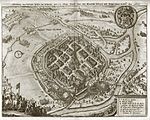Church of All Saints (Plzeň)
Buildings and structures completed in the 14th centuryChurches in Plzeň

The Church of All Saints (Czech: Kostel Všech svatých) is situated in the Roudna quarter near the historic center of Pilsen. It is one of the oldest churches in the area and it was considered the main parish church of the early villages of Pilsen, Malice and Zahorsko before the construction of the St. Bartholomew cathedral was completed.
Excerpt from the Wikipedia article Church of All Saints (Plzeň) (License: CC BY-SA 3.0, Authors, Images).Church of All Saints (Plzeň)
Pod Všemi svatými, Pilsen Plzeň
Geographical coordinates (GPS) Address Nearby Places Show on map
Geographical coordinates (GPS)
| Latitude | Longitude |
|---|---|
| N 49.7585244 ° | E 13.3794806 ° |
Address
Pod Všemi svatými
301 12 Pilsen, Plzeň
Southwest, Czechia
Open on Google Maps










